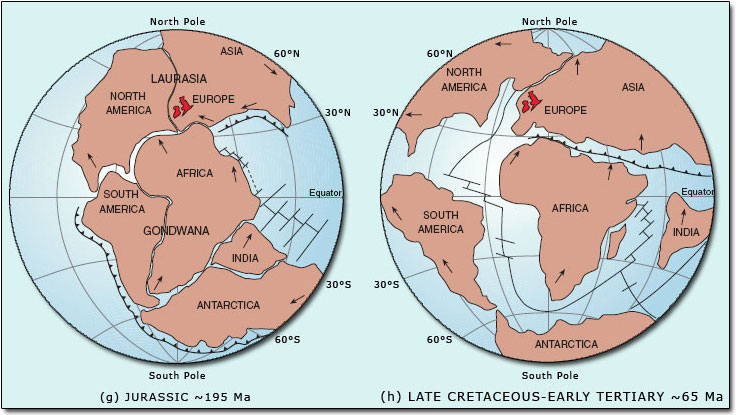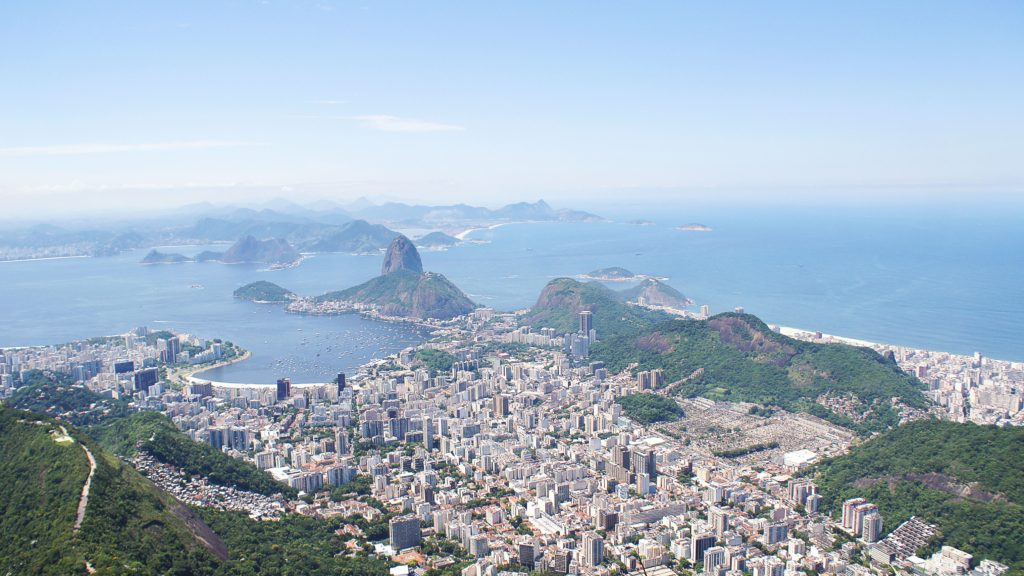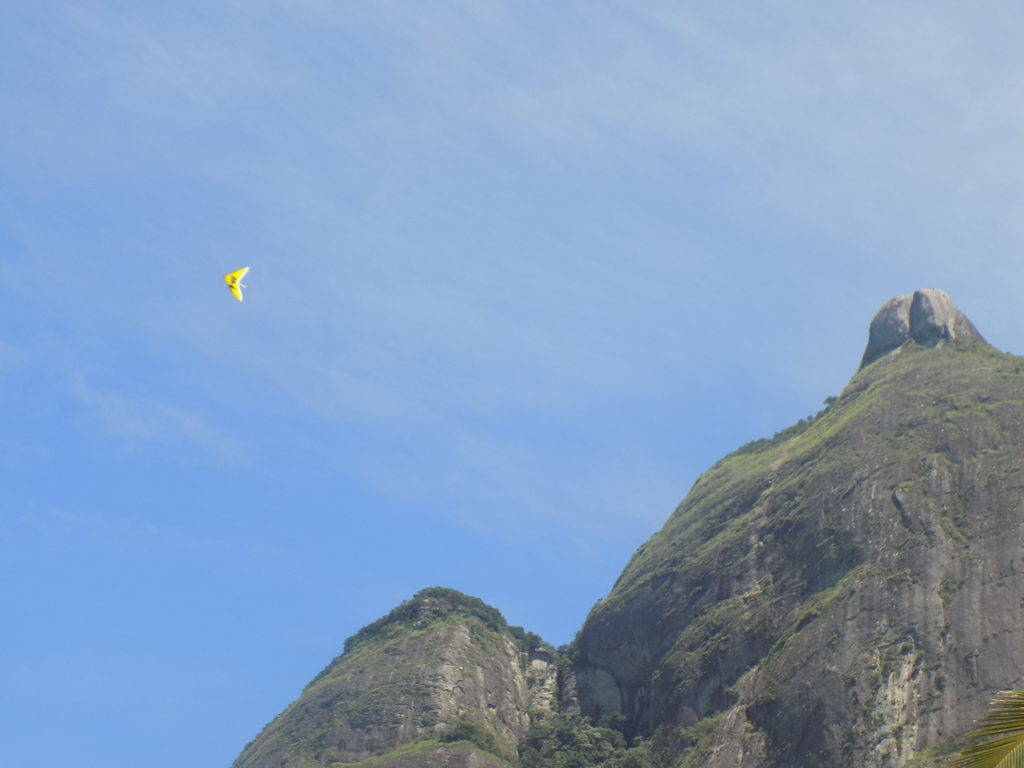After a night’s sleep and a day to adjust to the jump in temperature, I woke up Thursday morning ready to explore Rio beyond the immediate area of the hotel. However, before I bring you along with our small group on our city tour, I will ask your indulgence as I detour into a bit of deep geological history. It’s important to address this now not merely to gain some understanding of Rio’s present appearance but also because some of these same forces will come into play later in this cross-continent journey.
Gonna wander back to Gondwana
I suspect that anyone who has looked at a globe or a global map has noticed that it takes little imagination to envision the east coast of South America connecting with Africa’s west coast and locking together rather like a jigsaw puzzle. It might have looked something like this:
(Rights to John Pangaea)
As you can see, the breakup of the super continent occurred relatively recently – at least from a geological perspective. The map above shows the approximate configuration of Gondwana in the late Jurassic period about 195 million years ago. South America’s divorce from Africa (which was really neither’s fault – they simply drifted apart) began in the early Cretaceous or about 140 million years ago. (Despite the lack of evidence, some people argue that Africa’s desire for big brained hominid children – the continent did give rise to the earliest hominids some 5.8 to 6 million years ago after all – prompted the breakup.) One outcome of the split is that over the next 75 to 100 million years give or take we see the opening of the south Atlantic.
But the period wasn’t characterized by tectonic movement and ocean creation alone. As the gulf between the continents widened, four major oceanic segments marked by three fracture zones make convenient markers to define sections within the southern Atlantic.
(A fracture zone is a long, narrow rift on the ocean floor separating areas of differing depth of up to 1.5 kilometers. Of importance to the present discussion is that in places where such a zone crosses a mid-ocean ridge, it displaces the ridge by faulting. Faulting, of course, occurs in the Earth’s crust as a brittle response to stress which, in turn, is generally caused by plate tectonics.
In the present instance we must focus our attention on the southern segment demarcated by the Florianopolis Fracture Zone on the north and the Agulhas-Falkland Fracture Zone on the south. It’s the volcanic and tectonic activity in this range that will not only give rise to the rock formations dotting the general area of Rio de Janeiro but will, through the magmatism of the Tristan da Cunha hotspot also engender the Paraná Basin and provide the tectonic energy to elevate the Andes Mountains – both of which we will encounter as the journey progresses.)
Rio’s formations might look imposing but they’re really gneiss. Please don’t take them for granite
Mention Rio de Janeiro and it’s probable that it immediately evokes visions of beaches, bikinis, Speedos, and Carnival. It’s also likely that when you think of Rio an image something like this one
that includes Carioca landscapes, dynamic urban constructions, and beaches nestled between bornhardts enters your imagination. While the term bornhardt – a dome-shaped, steep-sided, bald rock outcropping at least 30 meters in height and several hundred meters in width and named after Wilhelm Bornhardt the German geologist who first described the feature – might not come to mind, the domed hills and mountains such as Corcovado and Pão de Açúcar (Sugarloaf Mountain) – the latter visible in this photo – almost certainly do.
On 3 April 1832, the HMS Beagle sailed into Guanabara Bay. Its most famous passenger, Charles Darwin decided to explore the geology of the immediate region and climbed the nearly 400 meters to the top of Pão de Açúcar. His description,
This whole district is almost exclusively formed of gneiss, abounding with garnets, and porphyritic with large crystals, even three and four inches in length, of orthoclase feldspar: in these crystals, mica and garnets are often enclosed.
Nothing can be more striking than the effect of these huge rounded masses of naked rock rising out of the most luxuriant vegetation.
was quite accurate.
How did these “huge rounded masses of naked rock” come to be? Here’s how: Gondwana had begun to slowly break apart hundreds of millions of years before the rift that would separate South America from Africa. Throughout both processes, large bodies formed from magma fed by the Tristan da Cunha hotspot intruded into the weakened crust.
(A hot spot is a place where plumes of molten lava rise from deep within the Earth’s mantle and melt through the overlying tectonic plate. This process supplies magma to seamounts which are individual volcanoes on the ocean floor.
A tectonic plate passing over a hot spot creates a chain of volcanoes. The Hawaiian Islands, the Azores, and the Galapagos Islands are examples of hot spot chains.
As for Tristan da Cunha, it is considered the world’s most isolated populated island. You can find its general location in the middle of the southern Atlantic by drawing a line from Cape Town, South Africa to Florianopolis, Brazil.)
As they cooled in the upper crust these magmatic bodies formed a large granitic pluton (any igneous body emplaced and cooled beneath the Earth’s surface). During the movement of the continents parts of the pluton broke apart, a process of metamorphism and deformation of the rocks occurred, and the cleavage of the gneiss formed. More recently, the metamorphic pluton was pushed upward. Darwin’s assessment of the mountain’s composition was correct. Hard augen-gneiss towered above weaker rocks which had slowly eroded and formed the dramatic modern landscape of Rio. The hard gneiss could date back as much as 570 million years. (The fact that similar magmatic structures can be found along the coasts of both Africa and South America presents further evidence of continental drift.)
While Corcovado and Pão de Açúcar are probably the best known formations, our first stop was along the beach and included views of two other bornhardts, the Morro Dois Irmãos or Two Brothers Mountain and Pedra da Gávea. To reach them, we traveled east for about 10 kilometers passing through a tunnel that had been enlarged for the 2016 Olympic games. Along the way, we also passed but didn’t enter Rocinha the largest favela (slum) in Brazil. We made our way toward the gneiss duoliths at the eastern end of the world’s largest urban forest Tijuca National Park before stopping by the ocean where we spent a few minutes watching the tandem hang gliders soar above us and touch down on San Conrado beach.
Note: In keeping with my 2022-2023 reformation of the blog into shorter entries, backdated to maintain their sequence, any comments on this post might pertain to its new configuration. See the explanation in the post Conventions and Conversions.



Terrible puns, Todd, but a great read as always! Thanks for taking us traveling with you!
I guess I’ll have to work on upgrading my puns.
I thought the puns were gneiss and I don’t take them for granite.
Well thank you very much.
Dude, you always crack me up…… I love the geological discussion as analogy for divorce.
What spectacular views. Sorry to hear the “renowned” restaurant wasn’t what expected. Have had that experience often when traveling. Find that random wandering often brings one to little known gems of local eateries. S
Thanks for much for taking the time to create these travelogues.
I love them!
Thanks, CB
Sure beats Huntington Beach!!, C’mon over nonetheless!!
Someday.
Thanks Todd, it was great to relive the day especially the singing cabbie! Very much enjoyed the geology and history narratives.
So happy you’re reading & enjoying!